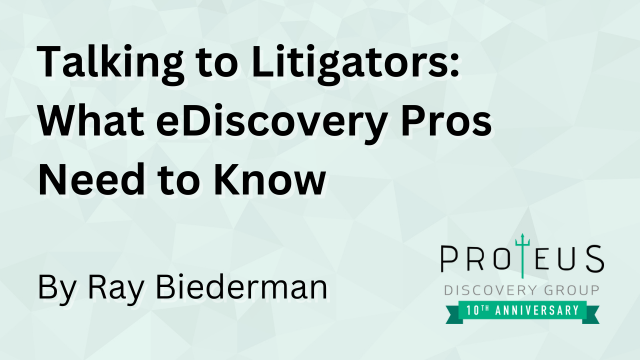
[EDRM Editor’s Note: EDRM is happy to amplify our Trusted Partners news and events.]
eDiscovery is now a standard part of trial prep and case strategy. But despite the technology’s evolution, many vendors still miss the mark in how they engage litigators. To dive deeper into this disconnect, and how to bridge it, I sat down for a post-webinar chat with Francesca Morency, Partner at Orrick, Herrington & Sutcliffe. Framing the conversation around the EDRM, we answer the questions: What do litigators actually care about? And where are eDiscovery professionals wasting their time and breath?
For context, Francesca has worked with Proteus Discovery on a number of matters, and we recently did a webinar with EDRM titled “How to Talk to Litigators About eDiscovery”.
RAY: Good morning, Francesca. For context to our readers, I know you because Proteus Discovery has worked with Orrick – and you personally – on a number of matters over the years.
So now that I’ve got you back in the hot seat, let’s start with trial prep in the early stages of the EDRM: Data Collection. Be honest, where do your eyes start to glaze over?
FRANCESCA: At that stage, my main focus is how we can handle data collection in a way that isn’t going to disrupt my client’s operations. I like to prepare my client for a collection strategy that’s comprehensive but not scorched earth. And the timeline is key. I need to know how long each step will take so I can manage expectations. And we’ll want to understand the status of the litigation holds, specifically what is already in place and working, and where we need to get them in place asap.
At that stage, my main focus is how we can handle data collection in a way that isn’t going to disrupt my client’s operations. I like to prepare my client for a collection strategy that’s comprehensive but not scorched earth.
Francesca Morency, Partner, Orrick, Herrington & Sutcliffe.
But while we’re on the topic, let’s not gloss over the issue of case budget. I want to know how we can be fully compliant but not spend a fortune. I rely on my eDiscovery partner to help ensure we’re being thorough without being wasteful.
RAY: That reminds me, on one of our last cases, custodial interviews came up as a pain point.
FRANCESCA: They’re tedious but essential. Getting the right people identified early prevents headaches later. And yes, I want to be involved in that process. It makes everyone more accountable, and frankly, I don’t want surprises when it’s time to produce.
RAY: Okay now to the fun part – data processing and analytics! Everyone’s favorite.
FRANCESCA: Oh boy.
RAY: I know. This is where eDiscovery folks often try to dazzle with tools and dashboards, but let’s be real, not every case needs a Cadillac. And in most cases, the tried-and-true approach is more than adequate.
FRANCESCA: Exactly. I don’t need to know every detail about document clustering or deduplication. On the processing side, it’s: When will the work be done, is it being done accurately, and is it going to blow my case budget. That’s it.
On the analytics side, however, I do appreciate the visuals that help me explain the process when necessary. A judge will often take your findings at face value as long as you can verify you’ve done it properly, but sometimes they want to dig a little deeper and see more of the process that went into the work. And having those visuals handy helps me explain the process in a way that is more relatable.
RAY: Let’s talk about the new kid on the block: generative AI. Any concerns with the use of AI in document review?
FRANCESCA: It’s good to understand what the AI is doing verses the human reviewers because it’s important to understand any risks that might be associated with the use of the technology. And each party needs to have a clear understanding of the process and potential risks and be able to make decisions about what tools and technology are going to be used during the review process. If things go awry, it’ll be the litigator whose name is associated there.
RAY: So you want a vendor who will discuss with you any technology being used before deciding which path to go down?
FRANCESCA: Yes – my eDiscovery partner needs to be able to explain in 5th grade language what technology is being used, what it’s going to do, and any error risks associated.
Yes – my eDiscovery partner needs to be able to explain in 5th grade language what technology is being used, what it’s going to do, and any error risks associated.
Francesca Morency, Partner, Orrick, Herrington & Sutcliffe.
RAY: Thanks so much for talking through this with me, it’s refreshing to get your perspective, and it helps me know where to lean in when we’re talking eDiscovery.
FRANCESCA: Anytime, Ray. It’s my pleasure!
Want more insights? Check out our recent EDRM webinar, “How to Talk to Litigators About eDiscovery”, where we dig into these topics (and more) in real time.
Assisted by GAI and LLM Technologies per EDRM GAI and LLM Policy.


